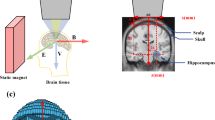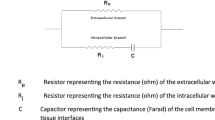Abstract
Electrical impedance tomography (EIT) is a medical imaging method with the potential to image resistance changes which occur during neuronal depolarisation in the brain with a resolution of milliseconds and millimetres. Most biomedical EIT is conducted with applied current over 10 kHz, as this reduces electrode impedance and so instrumentation artefact. However, impedance changes during neuronal depolarization are negligible at such frequencies. In order to estimate optimal recording frequency and specify instrumentation requirements, we have modelled their amplitude and frequency dependence during evoked activity using cable theory. Published values were used for the electrical properties and geometry of cell processes. The model was adjusted for the filtering effect of membrane capacitance and proportion of active neurons. At DC, resistance decreases by 2.8 % in crab nerve during the compound action potential and 0.6 % (range 0.06–1.7 %) locally in cerebral cortex during evoked physiological activity. Both predictions correlate well with independent experimental data. This encourages the view that true tomographic imaging of fast neural activity in the brain is possible, at least with epicortical electrodes in the first instance. It is essential to undertake this at low frequencies below about 100 Hz as above 1 kHz the signal becomes vanishingly small.





Similar content being viewed by others
References
Araki T, Terzuolo CA (1962) Membrane currents in spinal motoneurons associated with the action potential and synaptic activity. J Neurophysiol 25:772–789
Boone KG (1995) The possible use of applied potential tomography for imaging action potentials in the brain. University College London, London
Cole SK, Curtis HJ (1939) Electrical impedance of the squid giant axon during activity. J Gen Physiol 22:649–670
Elul R (1967) Amplitude histograms of the EEG as an indicator of the cooperative behavior of neuron populations. Electroencephalogr Clin Neurophysiol 23:87
Freygang WH, Landau WM (1955) Some relations between resistivity and electrical activity in the cerebral cortex of the cat. J Cell Compar Physiol 45:377–392
Galambos R, Velluti R (1968) Evoked resistance shifts in unanesthetized cats. Exp Neurol 22:243–252
Gilad O, Holder DS (2009) Impedance changes recorded with scalp electrodes during visual evoked responses: implications for electrical impedance tomography of fast neural activity. Neuroimage 47:514–522
Gilad O, Horesh L, Holder DS (2007) Design of electrodes and current limits for low frequency electrical impedance tomography of the brain. Med Biol Eng Comput 45:621–633
Gilad O, Ghosh A, Oh D, Holder DS (2009) A method for recording resistance changes non-invasively during neuronal depolarization with a view to imaging brain activity with electrical impedance tomography. J Neurosci Methods 180:87–96
Gilad O, Horesh L, Holder DS (2009) A modelling study to inform specification and optimal electrode placement for imaging of neuronal depolarization during visual evoked responses by electrical and magnetic detection impedance tomography. Physiol Meas 30:S201–S224
Grech R, Cassar T, Muscat J, Camilleri KP, Fabri SG, Zervakis M, Xanthopoulos P, Sakkalis V, Vanrumste B (2008) Review on solving the inverse problem in EEG source analysis. J Neuroeng Rehabil 5:25
Hillman EM, Amoozegar CB, Wang T, McCaslin AF, Bouchard MB, Mansfield J, Levenson RM (2011) In vivo optical imaging and dynamic contrast methods for biomedical research. Philos Transact A Math Phys Eng Sci 369:4620–4643
Hodgkin AL (1947) The membrane resistance of a non-medullated nerve fibre. J Physiol 106:305–318
Hodgkin AL (1954) A note on conduction velocity. J Physiol 125:221–224
Hodgkin AL, Rushton WAH (1946) The electrical constants of a crustacean nerve fibre. In: Proceedings of the royal society of London series B, biological sciences (1934–1990), vol 133, pp 444–479
Hofner N, Albrecht HH, Cassara AM, Curio G, Hartwig S, Haueisen J, Hilschenz I, Korber R, Martens S, Scheer HJ, Voigt J, Trahms L, Burghoff M (2011) Are brain currents detectable by means of low-field NMR? A phantom study. Magn Reson Imaging 29:1365–1373
Holder DS (1987) Feasibility of developing a method of imaging neuronal activity in the human brain: a theoretical review. Med Biol Eng Comput 25:2–11
Holder DS (1989) Impedance changes during evoked nervous activity in human subjects: implications for the application of applied potential tomography (APT) to imaging neuronal discharge. Clin Phys Physiol Meas 10:267–274
Holder DS (2005) Electrical impedance tomography: methods, history and applications, 1st edn. Taylor and Francis, London
Holder DS, Gardner-Medwin AR (1988) Some possible neurological applications of applied potential tomography. Clin Phys Physiol Meas 9(Suppl A):111–119
Keynes RD (1951) The leakage of radioactive potassium from stimulated nerve. J Physiol 113:99–114
Keynes RD, LEWIS PR (1951) The resting exchange of radioactive potassium in crab nerve. J Physiol 113:73–98
Kim HJ, Kim YT, Minhas AS, Jeong WC, Woo EJ, Seo JK, Kwon OJ (2009) In vivo high-resolution conductivity imaging of the human leg using MREIT: the first human experiment. IEEE Trans Med Imaging 28:1681–1687
Klivington KA, Galambos R (1967) Resistance shifts accompanying the evoked cortical response in the cat. Science 157:211–213
Klivington KA, Galambos R (1968) Rapid resistance shifts in cat cortex during click-evoked responses. J Neurophysiol 31:565–573
McCann H, Polydorides N, Murrieta-Lee JC, Ge K, Beatty P, Pomfrett CJ (2006) Sub-second functional imaging by electrical impedance tomography. Conf Proc IEEE Eng Med Biol Soc 1:4269–4272
Nicholson PW (1965) Specific impedance of cerebral white matter. Exp Neurol 13:386–401
Ochs S (1956) The direct cortical response. J Neurophysiol 19:513–523
Oh T, Gilad O, Ghosh A, Schuettler M, Holder DS (2011) A novel method for recording neuronal depolarization with recording at 125–825 Hz: implications for imaging fast neural activity in the brain with electrical impedance tomography. Med Biol Eng Comput 49:593–604
Parkes LM, de Lange FP, Fries P, Toni I, Norris DG (2007) Inability to directly detect magnetic field changes associated with neuronal activity. Magn Reson Med 57:411–416
Rafiei-Naeini M, McCann H (2008) Low-noise current excitation sub-system for medical EIT. Physiol Meas 29:S173–S184
Rall W (1977) The Nervous System 1-Core conductor theory and cable properties of neurons. In: Kandel ER (ed) Part 1, cellular biology of neurons. Am Physiol Soc, Bethseda, MD, pp 39–97
Ranck JB Jr (1966) Electrical impedance in the subicular area of rats during paradoxical sleep. Exp Neurol 16:416–437
Ranck JB Jr (1963) Specific impedance of rabbit cerebral cortex. Exp Neurol 7:144–152
Ranck JB Jr (1963) Analysis of specific impedance of rabbit cerebral cortex. Exp Neurol 7:153–174
Sadleir RJ, Grant SC, Woo EJ (2010) Can high-field MREIT be used to directly detect neural activity? Theoretical considerations. Neuroimage 52:205–216
Segev I, Rall W (1998) Excitable dendrites and spines: earlier theoretical insights elucidate recent direct observations. Trends Neurosci 21:453–460
Segev I, Schneidman E (1999) Axons as computing devices: basic insights gained from models. J Physiol Paris 93:263–270
Taber KH, Hillman EM, Hurley RA (2010) Optical imaging: a new window to the adult brain. J Neuropsychiatry Clin Neurosci 22:iv, 357–iv, 360
Van Harreveld A, Murphy T, Nobel KW (1963) Specific impedance of rabbit’s cortical tissue. Am J Physiol 205:203–207
Wolfe J, Houweling AR, Brecht M (2010) Sparse and powerful cortical spikes. Curr Opin Neurobiol 20:306–312
Acknowledgments
The authors would like to thank Ori Gilad for reviewing the manuscript and for helpful suggestions.
Author information
Authors and Affiliations
Corresponding author
Rights and permissions
About this article
Cite this article
Liston, A., Bayford, R. & Holder, D. A cable theory based biophysical model of resistance change in crab peripheral nerve and human cerebral cortex during neuronal depolarisation: implications for electrical impedance tomography of fast neural activity in the brain. Med Biol Eng Comput 50, 425–437 (2012). https://doi.org/10.1007/s11517-012-0901-0
Received:
Accepted:
Published:
Issue Date:
DOI: https://doi.org/10.1007/s11517-012-0901-0




